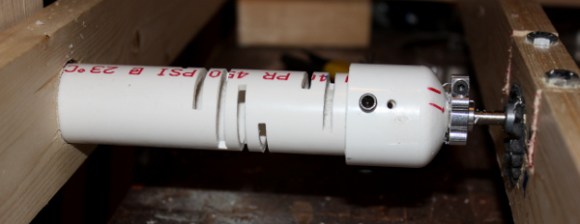
Our old pal [Jeremy Cook] is doing his own remix of [Theo Jansen]’s Strandbeest, and like the original, he’s using PVC pipe. Unlike the originals, he’s powering it with motors, not wind, and this has caused a few problems in transmitting mechanical power through a piece of PVC. Nothing is perfect, and in a few points in the legs movement the shaft shakes violently. One motor was lost and another nearly so before [Jeremy] came up with a flex coupler made from PVC.
The technique [Jeremy] is using has seen a lot of use with people building laser cut enclosures. It’s called kerf bending, and it works simply by cutting a few slits in a panel that allow it to bend slightly. This technique was replicated by [Jeremy] on a miter saw, cutting eight slots halfway through a one inch PVC pipe, with each successive cut offset 90 degrees.
The new design works well for transmitting power, and he’s not ruining motors any more. Check out the video below.
















The guy must be a plumber !
No other reason for punching holes in the middle of a load bearing
wood joist. As an architect, I would fail the work and force the contractor
to eat the costs of repairing the damage.
You simply do NOT punch holes in the middle of a piece of wood
that’s supposed to carry any appreciable loads. There are definite
rules to adhere to (in terms of size of hole, distances, etc).
I’ve witnessed electricians drill a hole in a main engineered truss
totally ruining it’s designed capacity (that put the contractor out of
business, and the lawsuits afterwards got ugly).
This is one small motor turning a huge amount of wood. Jeremy, did you calculated the needed motor-strength correctly?
I doesn’t look like he did. Just from the look of the setup, force multiplication has taken place to add more stress on the motor. Even if he used a more powerful motor, the multiplication would still take place and end up snapping the pipe again. He might want to used a worm-gear setup to turn that “crank” using a high speed motor. Just a thought though.
+1
Hi Indyaner – my “calculation” on this consisted of pushing on the driving piece of wood, and guessing at what force was required at the distance. The motors used are extremely gear reduced, and produce something on the order of 5 ft-lb of torque.
It’s probably not the most carefully designed device in the world (at least on my end), but that’s the beauty of hacking stuff together in your garage!
That thing is actually called a helical or beam coupling.
Thanks for the input – I’ll have to add that to the project description!
This problem looks like it would be easily solved if more care was taken when boring the holes supporting the PVC. From the video, it looks as though the entire pipe section is misaligned, not bent.
the assembly might move in relation to the holes as the sculpture moves. This hack allows the relationship between the two to change as the wood flexes under weight and different distributions of load. I wish I’d seen this last time I tried to build an electric go kart out of junk- we built an “air bag” suspension out of inner tube but could not figure out how to make a decent U joint without spending more time than needed for an afternoon goof off project. This pipe based driveshaft wouldve served admirably for the few hours of thrashing about the yard. I know it’ll fail eventually due to material fatigue but for a while, it’ll fit the bill.
90 degrees?
one half pi radians?
Just seeing “laser” and “PVC” in the same post makes me nervous. Do not combine the two!
Why not?
Some of us like rusty lasers and exhaust fans.
ooo, high torque flexible driveshaft made from crap lying around. excellent hack!
Thanks! I was happy with how it turned out.
Back in the early 60’s one US car maker made a car with a flexible driveshaft to lower the hump down the middle. I wonder how many TSB’s it had.
Gears. That PVC is going to explode with any load. It is one thing walking up on saw horses, but another all together when you get lit some night and want to take the beest out for a walk with you on its back. At at style. Gears. Even the toy model has gears.
Thanks for the excellent writeup Brian!